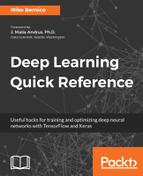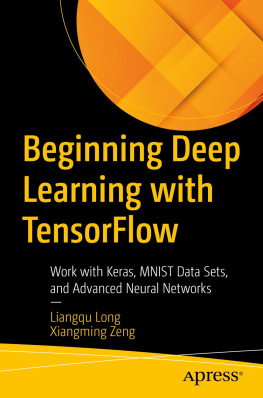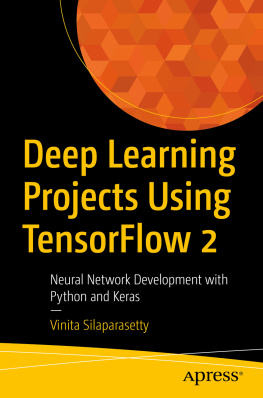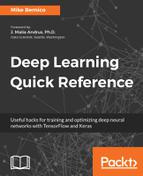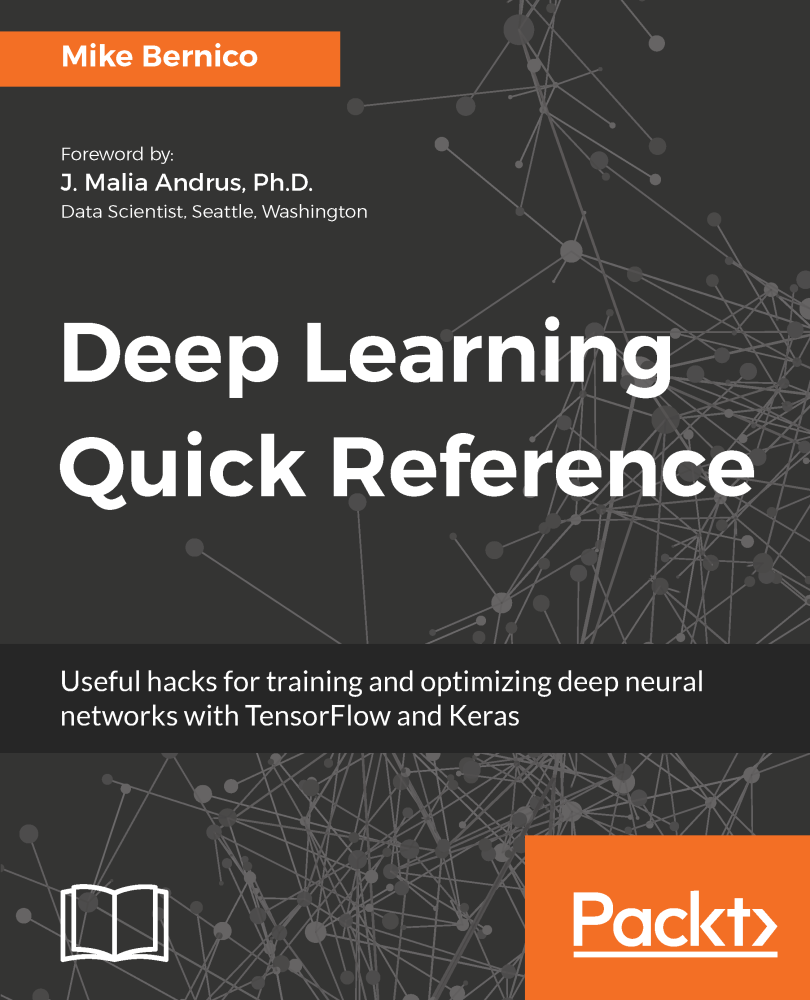Mike Bernico - Deep Learning Quick Reference: Useful hacks for training and optimizing deep neural networks with TensorFlow and Keras
Here you can read online Mike Bernico - Deep Learning Quick Reference: Useful hacks for training and optimizing deep neural networks with TensorFlow and Keras full text of the book (entire story) in english for free. Download pdf and epub, get meaning, cover and reviews about this ebook. year: 2018, publisher: Packt Publishing, genre: Home and family. Description of the work, (preface) as well as reviews are available. Best literature library LitArk.com created for fans of good reading and offers a wide selection of genres:
Romance novel
Science fiction
Adventure
Detective
Science
History
Home and family
Prose
Art
Politics
Computer
Non-fiction
Religion
Business
Children
Humor
Choose a favorite category and find really read worthwhile books. Enjoy immersion in the world of imagination, feel the emotions of the characters or learn something new for yourself, make an fascinating discovery.
- Book:Deep Learning Quick Reference: Useful hacks for training and optimizing deep neural networks with TensorFlow and Keras
- Author:
- Publisher:Packt Publishing
- Genre:
- Year:2018
- Rating:3 / 5
- Favourites:Add to favourites
- Your mark:
Deep Learning Quick Reference: Useful hacks for training and optimizing deep neural networks with TensorFlow and Keras: summary, description and annotation
We offer to read an annotation, description, summary or preface (depends on what the author of the book "Deep Learning Quick Reference: Useful hacks for training and optimizing deep neural networks with TensorFlow and Keras" wrote himself). If you haven't found the necessary information about the book — write in the comments, we will try to find it.
Dive deeper into neural networks and get your models trained, optimized with this quick reference guide
Key Features- A quick reference to all important deep learning concepts and their implementations
- Essential tips, tricks, and hacks to train a variety of deep learning models such as CNNs, RNNs, LSTMs, and more
- Supplemented with essential mathematics and theory, every chapter provides best practices and safe choices for training and fine-tuning your models in Keras and Tensorflow.
Deep learning has become an essential necessity to enter the world of artificial intelligence. With this book deep learning techniques will become more accessible, practical, and relevant to practicing data scientists. It moves deep learning from academia to the real world through practical examples.
You will learn how Tensor Board is used to monitor the training of deep neural networks and solve binary classification problems using deep learning. Readers will then learn to optimize hyperparameters in their deep learning models. The book then takes the readers through the practical implementation of training CNNs, RNNs, and LSTMs with word embeddings and seq2seq models from scratch. Later the book explores advanced topics such as Deep Q Network to solve an autonomous agent problem and how to use two adversarial networks to generate artificial images that appear real. For implementation purposes, we look at popular Python-based deep learning frameworks such as Keras and Tensorflow, Each chapter provides best practices and safe choices to help readers make the right decision while training deep neural networks.
By the end of this book, you will be able to solve real-world problems quickly with deep neural networks.
What you will learn- Solve regression and classification challenges with TensorFlow and Keras
- Learn to use Tensor Board for monitoring neural networks and its training
- Optimize hyperparameters and safe choices/best practices
- Build CNNs, RNNs, and LSTMs and using word embedding from scratch
- Build and train seq2seq models for machine translation and chat applications.
- Understanding Deep Q networks and how to use one to solve an autonomous agent problem.
- Explore Deep Q Network and address autonomous agent challenges.
If you are a Data Scientist or a Machine Learning expert, then this book is a very useful read in training your advanced machine learning and deep learning models. You can also refer this book if you are stuck in-between the neural network modeling and need immediate assistance in getting accomplishing the task smoothly. Some prior knowledge of Python and tight hold on the basics of machine learning is required.
Table of Contents- The Building Blocks of Deep Learning
- Using Deep Learning To Solve Regression Problems
- Monitoring Network Training Using Tensor Board
- Using Deep Learning To Solve Binary Classification Problems
- Using Keras To Solve MultiClass Classification Problems
- HyperParameter Optimization
- Training a CNN From Scratch
- Transfer Learning with Pretrained CNNs
- Training an RNN from scratch
- Training LSTMs with Word Embeddings From Scratch
- Training Seq2Seq Models
- Using Deep Reinforcement Learning
- Deep Convolutional Generative Adversarial Networks
Mike Bernico: author's other books
Who wrote Deep Learning Quick Reference: Useful hacks for training and optimizing deep neural networks with TensorFlow and Keras? Find out the surname, the name of the author of the book and a list of all author's works by series.

